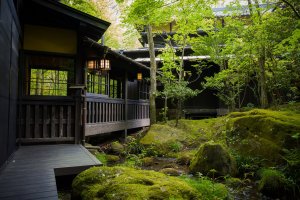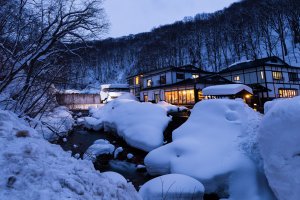When it comes to selecting accommodation for your travels through Japan, there are a plethora of options to choose from. One style of lodging you may want to consider are ryokan. These traditional Japanese inns give you a unique insight into Japanese culture, but there are elements of a ryokan stay which are different from that of a standard hotel.
Find out what to expect from a ryokan stay, and tips on how to ensure it’s a pleasant, memorable experience.
History of ryokan
With a history dating back to the eighth century, ryokan are fixtures in Japanese culture. Originally, the guest houses we now know as “ryokan” were referred to as fuseya and were provided free of charge to travelers needing a room for the night. They’ve served roles in history as lodging for religious pilgrims, for those seeking medicinal cures from the country’s hot springs, and simply as a place to sojourn for those venturing beyond their local area.
These days, you’ll find ryokan all across Japan, and they run the gamut from basic on through to luxury accommodations.
Check-in procedures
Depending on the ryokan you stay at, your check-in procedures may be different. You may be greeted outside; you may simply head to the front desk in the same manner as you would at a regular hotel; or the staff may direct you to a lobby seating area where they will explain the amenities at the hotel to you.
If you are directed to a seating area to complete check-in procedures, it’s common to be offered a complimentary refreshment (usually green tea) and a snack, which is often some form of wagashi (traditional Japanese sweets).
Rooms
Bedding
Most ryokan offer futon-style bedding, where you will sleep on a mattress laid out on the floor. In many ryokan, you’ll find that the bedding is stored in a cupboard (you might not immediately see it when you first enter your room!) and laid out later in the evening by the staff, often when you’re at dinner.
Not so sure about sleeping on the floor? Some ryokan offer a choice of either futon bedding or western-style beds, and if this is the case you should be able to specify which you’d prefer during the booking process.
Bear in mind some ryokan in Japan still contain rooms, or entire premises, that allow for indoor smoking. Although not common to encounter, check in advance with your ryokan if this is an acute concern.
The attire
A great thing about staying at a ryokan is that comfort is key! You’ll typically find yukata available to wear, which are a robe-styled garment, often referred to as a more casual take on a kimono. Yukata are worn by both men and women, and if your ryokan offers them they will either be found in your room or provided during the check-in process by the staff. Some ryokan will even have a range of colors and designs of yukata to choose from, so you can pick a style that suits your personal preferences.
There is a specific way to tie your yukata, which is to firstly take the right side of the garment and wrap it around to your left hip. Then take the left side of the garment and wrap it to your right side. It’s a no-no to have your yukata finished with the right side over the left, since that’s how those who have passed away are dressed. Don’t sweat it if you make a mistake with it—the worst that’ll happen is that a staff member or another friendly patron will gently correct you.
A note for taller patrons: if the room does not have a yukata your size, you can request LL or LLL-sized yukata. The ryokan will have them on hand, just not in every room. Don’t expect the same for the ryokan’s sandal options, however!
The cuisine
Many ryokan offer meals (usually breakfast and dinner) as part of your stay, and most include this in the room rate when you make your booking. If you’d prefer to dine somewhere other than your ryokan, you can often select rates that only include the room. Depending on the location of your ryokan (particularly if it’s off the beaten path), you may find it more convenient eating on-site anyway.
Breakfasts are served in one of several ways. You may get a set meal, usually served in a bento, (the Japanese equivalent of a lunchbox). They may offer an all-you-can-eat style buffet, which usually consists of both Japanese and western elements. This can be convenient if you’d like to try several different dishes or if you or your traveling companions are picky eaters. Your ryokan may also serve a kaiseki (multi-course) breakfast, where various courses are brought out one after the other.
Dinners are most often served kaiseki-style, incorporating regional cuisine into the elements of the meal. Staying somewhere coastal? It’s likely your meal will comprise of many seafood variants. Tucked away at a mountainside retreat? You may find your dinner is filled with locally grown fruits, vegetables, and meat. Whatever is served, it’s a feast for all of the senses. Spend some time admiring the dishware your meal is served on—they’re often beautifully designed and reflect the seasons.
Your ryokan may serve your meals directly in your room; there may be a communal dining area; or there may even be individual dining rooms that are sectioned off from other patrons, giving you and your traveling companions some privacy. When checking in, the ryokan staff will inform you of where the meals are served and ask you to select a time frame for when you’d like to eat. These are usually presented to guests in either 15-minute or half-hour increments. Ensure you’re on time for the window you’ve selected if your meals aren’t served to your room directly.
Don’t forget to mention food preferences or intolerances
Be upfront with any food allergies and intolerances you (or anyone in your traveling party) may have. If you notify your ryokan ahead of time, they are usually able to amend the planned menu to ensure your meal is not only something you can eat, but will thoroughly enjoy.
Onsen
Bathing at a ryokan can also be different to what you may expect at a standard hotel. Some ryokan will not contain a private bath or shower in the room; in those cases, bathing is done communally at an on-site onsen.
Onsen typically refer to waters that are sourced from hot springs, but in a broader context many ryokan will refer to their communal baths as onsen, irrespective of whether the water source is a hot spring or not.
There are specific rules when it comes to onsen bathing which can be helpful to know ahead of time. Do bear in mind that if you have tattoos, most ryokan still have a “no tattoo” policy when it comes to public onsen. It’s important to be aware of these policies, particularly if you’re staying at an onsen without any in-room bathing facilities.
Finding a ryokan
The accommodation section of our website allows you to search specifically for traditional ryokan properties. The members of our Japan Travel community have personally stayed at these ryokan across the country; their photo stories and articles provide some insight into what staying at one of these traditional inns is like.
























